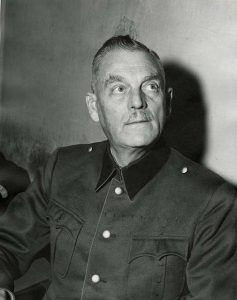Wilhelm Keitel is a name that resonates with the dark history of Nazi Germany during World War II. He was a prominent military officer and a central figure in Adolf Hitler’s inner circle.

Wilhelm Keitel was born on September 22, 1882, in the small village of Helmscherode, Germany. He hailed from a modest background, but his military ambitions led him to a career in the armed forces. Keitel’s military journey began during the era of the Weimar Republic, where he rose through the ranks.
Keitel’s ascent to notoriety occurred during the Nazi regime when he was appointed as the Chief of the Supreme High Command of the German Armed Forces (OKW). This position made him one of Hitler’s primary military advisors and a key enforcer of Hitler’s directives.gnnnn
As Chief of the OKW, Keitel played a pivotal role in coordinating and executing military campaigns during World War II. His loyalty to Hitler was unwavering, and he adhered to the Führer’s orders with unquestioning obedience. This loyalty often led him to be directly involved in implementing Hitler’s aggressive strategies.
Wilhelm Keitel’s legacy is deeply entwined with the numerous war crimes committed by Nazi Germany. He was instrumental in planning and executing some of the most notorious actions of the Nazi regime. The invasion of Poland in 1939, which marked the beginning of World War II, had Keitel’s fingerprints all over it.
Moreover, Keitel was implicated in the Holocaust, a systematic genocide in which millions of innocent people, primarily Jews, were exterminated. His role in orchestrating the atrocities was undeniable, as he was an essential figure in the chain of command responsible for these crimes against humanity.
After the end of World War II, Wilhelm Keitel was among the top Nazi leaders who faced justice at the Nuremberg Trials. The international tribunal held these trials to prosecute those responsible for war crimes, crimes against peace, and crimes against humanity.
At the Nuremberg Trials, Keitel was found guilty of war crimes and crimes against humanity, and his actions were described as “crimes that outraged the conscience of humanity.” His unwavering loyalty to Hitler, which had driven him to carry out these heinous acts, did not spare him from the judgment of the tribunal.
On October 16, 1946, Wilhelm Keitel was executed by hanging along with other high-ranking Nazi officials who had been sentenced to death.
Wilhelm Keitel’s life and career serve as a chilling reminder of the extent to which individuals can become entangled in the machinery of tyranny and brutality. His unwavering loyalty to Adolf Hitler led him down a path of destruction and infamy. While he may not be as widely recognized as some other Nazi leaders, his role in planning and executing war crimes during World War II remains a significant part of his historical legacy.
In a world marked by the horrors of war and totalitarianism, Wilhelm Keitel’s actions stand as a stark testament to the depths of human compliance and the moral imperative to resist such conformity. His life and the consequences he faced at the Nuremberg Trials serve as a haunting chapter in the annals of history, underscoring the critical importance of accountability for those who commit crimes against humanity.
Cite This Article
"Wilhelm Keitel: The Enigmatic Figure in Nazi Germany’s Hierarchy" History on the Net© 2000-2024, Salem Media.
April 28, 2024 <https://www.historyonthenet.com/wilhelm-keitel-the-enigmatic-figure-in-nazi-germanys-hierarchy>
More Citation Information.





